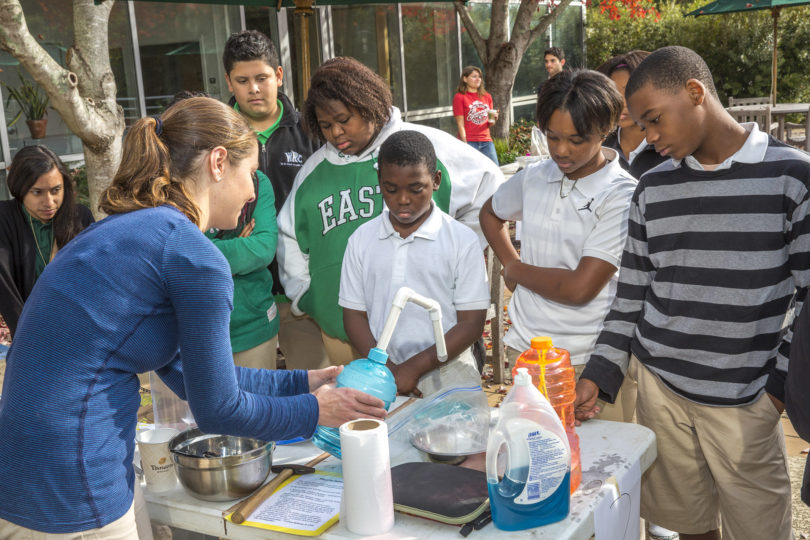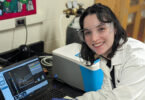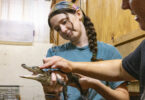The enthusiasm of more than 400 seventh-graders and their teachers bounced off the glass-windowed walls of the State Botanical Garden’s tropical conservatory Nov. 12 at the second annual Bioenergy Day @ UGA. It confirmed what its planners already knew: Hands-on science at UGA is a big hit, not only with students and their teachers, but also with UGA faculty and graduate students who participated.
“The kids are so excited,” said Carolyn Andrews, a seventh-grade science teacher at Coile Middle School. “Even though they are learning, they think it’s just fun.”
The UGA Bioenergy Systems Research Institute sponsored the event along with the Office of Service-Learning, the State Botanical Garden and the Office of Sustainability. Middle-schoolers need to see that “science is not just a textbook,” Andrews said. “Events like Bioenergy Day @ UGA connect them with real people who can tell them why science is so important.”
The UGA faculty and graduate students who brought their science to the event also were excited.
“I was surprised at the sheer number of kids,” said Jason Locklin, an associate professor in both the College of Engineering and the chemistry department in the Franklin College of Arts and Sciences. “I was also surprised by some of the really curious and pointed questions they asked.
“They quickly made the connections between the fundamental concepts and workings of these cells and the photosynthesis that was going on in all of the plants around us,” said Locklin, who demonstrated how to create solar cells from the dyes found in blackberries and raspberries with graduate students Anandi Roy and Deborah Lehman. “My grad students, who did all of the work, learned that it is always a great challenge to communicate scientific principles at different levels.”
The students crowded around tables in the Botanical Garden conservatory and its patios. Nine Farming for Fuels exhibits, developed by UGA staff from the BioEnergy Science Center, or BESC, and the Creative Discovery Museum in Chattanooga, Tennessee, introduced basic concepts such as the carbon cycle; how woody biomass, such as trees and grasses, can produce biofuels; and the
technical and economic obstacles to a bio-based fuel economy.
New this year were six exhibits staffed by UGA faculty and graduate students from the Franklin College, the College of Engineering, the College of Agricultural and Environmental Sciences, the Warnell School of Forestry and Natural Resources and the Complex Carbohydrate Research Center. In addition to Locklin’s solar cells, seventh-graders learned about generating fuel from photobioreactors and small-scale algae ponds; using anaerobic digestion to break down waste materials; breaking down plant cell walls; and how 3-D printing and augmented reality enhance research in the modern laboratory.
Jan Westpheling, a professor of genetics in the Franklin College who leads education and outreach for the BESC, said she hopes the event brings attention to UGA as a leader in bioenergy research.
“We’re working very hard to make this a sustainable source of energy for future generations,” she said. “I was blown away by how engaged the students were,” said Shannon Wilder, director of the Office of Service-Learning, which provides opportunities for all Clarke County students at each grade level to visit campus every year through the Experience UGA program.
“Hopefully, we have some future scientists who were really inspired by the day’s events,” she said.
“We received many positive comments from faculty who used this event as part of meeting the broader impacts of their research, as well as students who had a great time learning something new,” said Ryan Adolphson, BSRI associate director. “We’ve already started planning to bring Bioenergy Day back again next year.”








